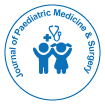Outline of Clinical Pathology
Received: 04-Apr-2022 / Manuscript No. jpms-22-60572 / Editor assigned: 06-Apr-2022 / PreQC No. jpms-22-60572 / Reviewed: 20-Apr-2022 / QC No. jpms-22-60572 / Revised: 25-Apr-2022 / Manuscript No. jpms-22-60572 / Accepted Date: 28-Apr-2022 / Published Date: 29-Apr-2022 DOI: 10.4172/jpms.1000176
Introduction
Pathologists are alluded to here and there incidentally as specialists of dead people. This has establishes in the normal thought that pathologists are just liable for doing dissections and giving pieces of information to the conceivable cause(s) of death. What highlight such confusions are the gear and strategies for pathologic assessments. A pathologist never utilizes the standard devices of customary actual assessments, for example, stethoscopes or sphygmomanometers. The person has additionally no immediate experience with patients. There is next to no similitude between the picture that individuals have as a top priority of a doctor and of a pathologist.
Pathology as a Medical and Research Discipline
In the investigation of medication, pathology capacities as an extension among essential and applied clinical [1] sciences and in this manner it assumes an exceptionally significant part not just in the comprehension of the pathophysiologic premise of infections yet additionally in deciphering it into the viable administration of patients and sickness tests. There are two fundamental ways of thinking about the act of pathology [2, 3]. In most European nations, a pathologist manages minute assessment of tissue examples (little biopsy tests as well as enormous resection examples) and cytological material. As an aide to this histologic and cytological assessment, a pathologist utilizes a few subordinate techniques (like immunohistochemistry (IHC) or atomic and hereditary assessments) for more precise finding, grouping, and anticipation of infections. In the United States, a pathologist is, furthermore, liable for all research facility examinations that are somewhere else covered by disciplines, for example, microbial science and lab medication. These investigations are completed on body liquids (blood, serous liquids, pee, dung, and so forth), discharges of organs (exocrine emissions of pancreas), or different materials that are taken out from or expectorated by a patient (sputum, covers of skin ulcers, and so on.). They cover an expansive range of indicative strategies separated from microscopy, including microbiologic, serologic, biochemical, and tiny assessments. In this part, any place we utilize the term pathology, it alludes basically to the plainly visible and tiny assessment as well as sub-atomic appraisals of tissue tests.
Historical Description
The minute examination of cells and tissue (e.g., cytology and histology) showed up without precedent for the nineteenth century as a significant technique for research and determination in the field of medication. By and large, Xavier Bichat is thought of as in most distributions as the author of pathology. The part of histopathology [4] showed up a few years after the fact, with Muller distributing a book on the primary attributes ¨ of disease cells and their development. Virchow, an understudy of Muller, presented ¨ the significant relationships be tween’s cells, which are the littlest units of crucial living beings and tissues, infection states, and related illness instruments. He became well known overall for his cell pathology [5] studies and his case that each infection starts from unhealthy cells or, as indicated by him, ''Omnis cellula e cellula.'' This explanation is substantial additionally today in the period of atomic pathology.
Acknowledgement
The authors are grateful to the, University of Michigan for providing the resources to do the research.
Conflict of Interest
The authors declared no potential conflicts of interest for the research, authorship, and/or publication of this article.
Citation: Thomas A (2022) Outline of Clinical Pathology. J Paediatr Med Sur 6: 176. DOI: 10.4172/jpms.1000176
Copyright: copy; 2022 Thomas A. This is an open-access article distributed under the terms of the Creative Commons Attribution License, which permits unrestricted use, distribution, and reproduction in any medium, provided the original author and source are credited.
Share This Article
Open Access Journals
Article Tools
Article Usage
- Total views: 1329
- [From(publication date): 0-2022 - Apr 05, 2025]
- Breakdown by view type
- HTML page views: 888
- PDF downloads: 441
